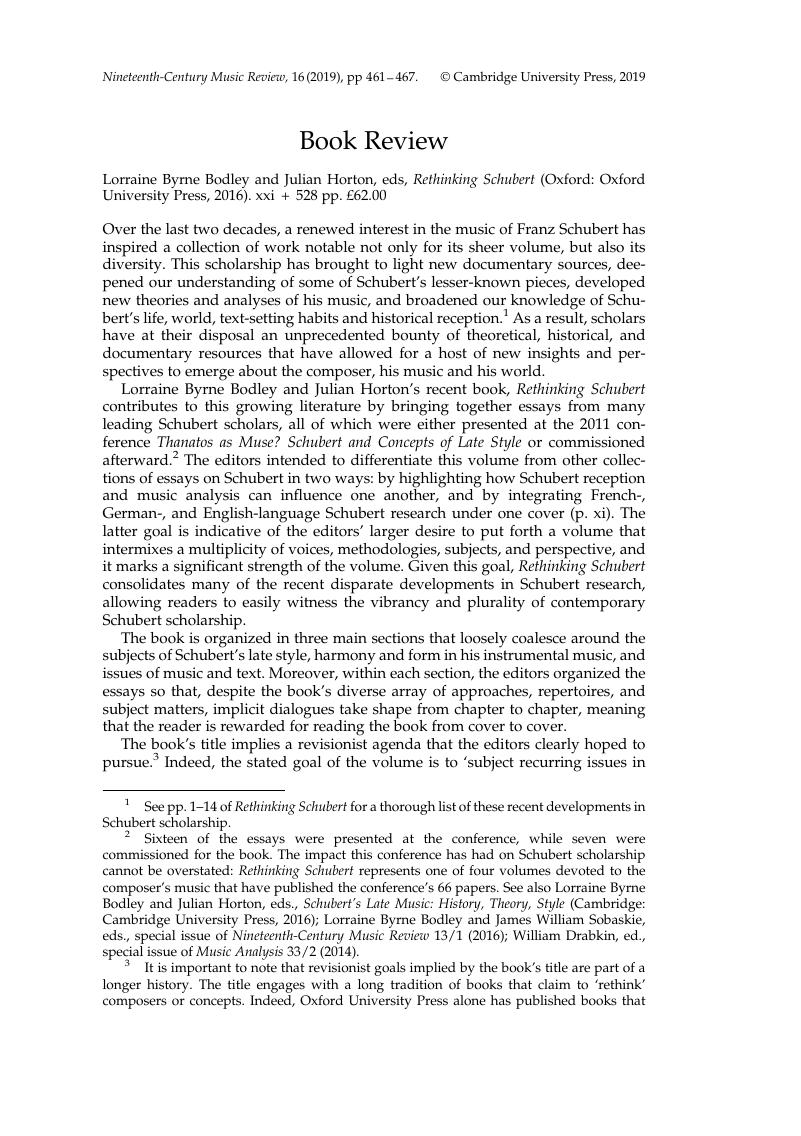No CrossRef data available.
Article contents
Lorraine Byrne Bodley and Julian Horton, eds, Rethinking Schubert (Oxford: Oxford University Press, 2016). xxi + 528 pp. £62.00
Review products
Published online by Cambridge University Press: 15 February 2019
Abstract

- Type
- Book Reviews
- Information
- Copyright
- Copyright © Cambridge University Press, 2019
References
1 See pp. 1–14 of Rethinking Schubert for a thorough list of these recent developments in Schubert scholarship.
2 Sixteen of the essays were presented at the conference, while seven were commissioned for the book. The impact this conference has had on Schubert scholarship cannot be overstated: Rethinking Schubert represents one of four volumes devoted to the composer’s music that have published the conference’s 66 papers. See also Bodley, Lorraine Byrne and Horton, Julian, eds., Schubert’s Late Music: History, Theory, Style (Cambridge: Cambridge University Press, 2016)CrossRefGoogle Scholar ; Lorraine Byrne Bodley and James William Sobaskie, eds., special issue of Nineteenth-Century Music Review 13/1 (2016); William Drabkin, ed., special issue of Music Analysis 33/2 (2014).
3 It is important to note that revisionist goals implied by the book’s title are part of a longer history. The title engages with a long tradition of books that claim to ‘rethink’ composers or concepts. Indeed, Oxford University Press alone has published books that purport to ‘rethink’ everything from Britten to music itself. Moreover, the association between revisionism and Schubert emerged over 20 years ago during the composer’s bicentennial year.
4 See for example, p. 3 of the Introduction, which specifically calls attention to ‘Damschroder’s imaginative rethinking of voice-leading techniques’ (p. 3).
5 For a critique of this revisionist concern, see Jonathan Guez, ‘Review of Lorraine Byrne Bodley and Julian Horton, eds. Rethinking Schubert (Oxford University Press, 2016)’, Music Theory Online 23/3 (September 2017).
6 Martin Cooper, Beethoven: The Last Decade, 1817–1827 (Oxford: Oxford University Press, 1970; rev. ed., 1985).
7 Although every chapter agrees that a stylistic shift occurred towards the end of Schubert’s life, the authors have different opinions on when exactly that happened. For instance, although Wollenberg states the shift took place in 1818 (p. 61), Kinderman suggests 1820 (p. 41). Dürr and Hinrichsen then pinpoint two further dates: 1824 (p. 22) and 1826 (p. 29) respectively.
8 Indeed, despite the points of implicit dialogue that occur between each chapter, Part I could have been strengthened by more explicit discussion between authors.
9 Schubert’s relationship to Beethoven is most thoroughly discussed in Kinderman’s chapter, ‘Franz Schubert’s “New Style” and the Legacy of Beethoven’ (pp. 41–60).
10 The movie is based on an operetta of the same title by Heinrich Berté (1916) as well as on the novel Schwammerl (p. 117).
11 Caitlin Martinkus, ‘The Urge to Vary: Schubert’s Variation Practice from Schubertiades to Sonata Forms’, (PhD diss., University of Toronto, 2017).
12 One of the most outspoken critics of taking the repeats is Alfred Brendel, who ‘makes a firm case for the omission of this expositional repeat, arguing that it exists only because Schubert, unlike Beethoven, was unable to “resist the pressures of convention”’ (p. 196).
13 Mi-Sook Han Hur, ‘Irregular Recapitulations in Schubert’s Instrumental Works’, (PhD diss., City University of New York, 1992), 91–9, and Aaron Grant, ‘Schubert’s Three-Key Expositions’, (PhD diss., Eastman School of Music, University of Rochester, 2018), 72–98.
14 Grant, ‘Schubert’s Three-Key Expositions’, 6–43.
15 Interestingly, despite their supposedly different approaches, the two authors’ occasionally make similar claims. For example, both authors note how the introductions of their respective songs foreshadow later musical events. Compare, for instance, Spitzer’s account of how the melodic structure of the introduction to ‘Im Freien’ predicts much of the song’s expressive ‘arc of intensification’ (p. 255) with Clark’s assertion that elements of the prelude to ‘Schwanengesang’ such as ‘modal mixture, the IAC cadence and the Ê♭ it highlights, as well as the ominous rhythm … permeate [the] song’ (p. 278).




